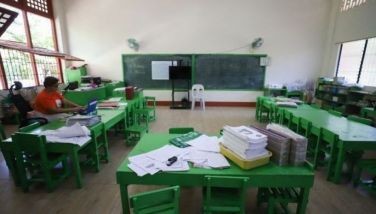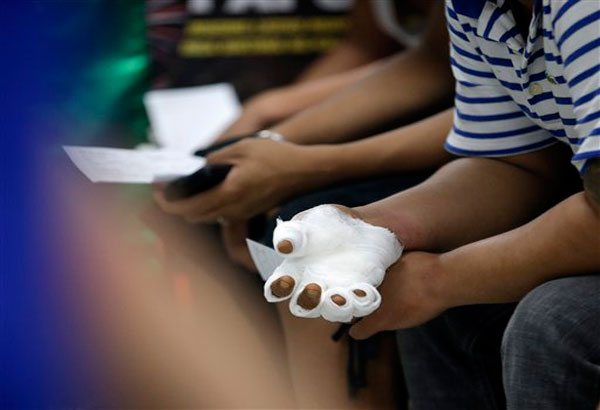US undaunted by Jolo attack
MANILA, Philippines - The death of two American soldiers and a Filipino Marine in Sulu last Tuesday will not break the resolve of the US government to help the Philippines in its time of need, US Ambassador Kristie Kenney said yesterday.
“What happened to the Filipino and US soldiers is completely devastating. They were supposed to build a school in a community in Jolo that needed education facilities. They lost their lives helping others and we are deeply touched. We are thankful to all Filipinos who send their sympathy and words of advice,” Kenney told reporters during a visit to an evacuation center in Tatalon, Quezon City.
Kenney said a contingent of US troops would be arriving in the country to assist in the ongoing relief and rehabilitation operations in Metro Manila.
The US troops based in Okinawa, Japan are arriving with heavy equipment, medicine and other necessities for distribution to the hundreds of thousands displaced by floodwaters and flashfloods caused by storm “Ondoy” last Saturday.
Kenney said the planned joint military exercise between US and Filipino forces would instead be transformed into an aid operation for survivors of the deadly weekend disaster.
“We are working with the Philippine armed forces to redirect a long-planned exercise,” Kenney told reporters.
“There will be medical teams, equipment to help clear debris, bulldozers, forklifts, and we will have some heavy-lift helicopters so we can help start cleaning up Manila so people can move on with their lives,” she said.
Kenney, along with some American soldiers and United States Agency for International Development personnel, joined Philippine National Red Cross (PNRC) volunteers led by chairman Sen. Richard Gordon in conducting cleanup operations in the school and giving relief goods to the evacuees.
Kenney said their focus right now is to help the people.
“There are Filipinos in need right now and we are not going to let them down.”
Armed Forces of the Philippines (AFP) spokesman Lt. Col. Romeo Brawner said five heavy trucks, five Humvees, one bulldozer, two forklifts and 30 US medical personnel had already arrived in the country to help in flood relief.
Kenney added the American contingent would bring other relief goods, including $4-million worth of medical supplies.
The ambassador did not specify how many US troops would arrive in the country.
“We will have medical teams of 30 to 40... How many will be needed to operate the trucks and forklifts, I don’t have that number,” she said.
Brawner said US troops are expected to be deployed in calamity-stricken areas around Metro Manila.
He said around 3,000 American troops from Okinawa and the US Pacific Command in Hawaii are scheduled to arrive today to participate in relief assistance projects.
Two teams of medical personnel would be initially sent to various parts of Metro Manila to attend to the medical needs of the evacuees and the number of US soldiers would increase later on, Brawner said.
The US government also committed six Chinook transport helicopters to facilitate the distribution of relief goods to the worst affected areas.
The US military earlier sent 17 Navy SEALS with rubber boats in the rescue operations at the height of the storm.
Brawner said the US troops will be heavily involved with the distribution of relief goods using trucks and helicopters, while the heavy equipment would be used for clearing roads and clogged waterways.
Kenney led the advance party yesterday, joined by a small contingent of US soldiers who came from Sulu to help in flood relief efforts.
The American troops came from the same unit of the two soldiers were killed by a roadside bomb in Sulu last Tuesday.
Asked if the US would ask for more security for its military personnel, Kenney said they do not intend to do so.
“I’m not doing anything about that. We work through them (the AFP) and will let them determine the next step because they are in charge,” Kenney said.
IED attack
President Arroyo, on the other hand, ordered Defense Secretary Gilbert Teodoro to leave the investigation of the roadside bombing in Sulu to the Anti-Terrorism Council (ATC) under Executive Secretary Eduardo Ermita.
The President directed Teodoro to focus on the ongoing relief and rehabilitation efforts.
The military, on the other hand, blamed the Abu Sayyaf bandit group for the roadside bombing that killed the two American servicemen and a Filipino Marine in Indanan last Tuesday.
Western Mindanao Command chief Maj. Gen. Benjamin Dolorfino said the Abu Sayyaf and its Jemaah Islamiyah cohorts could have used an improvised explosive device (IED) planted along the road in Barangay Kagay that wounded two other Filipino Marines.
The two American soldiers and a Filipino Marine were part of a contingent of a humanitarian mission to construct a clinic and a barangay hall in the area.
The slain American soldiers were identified as Staff Sergeant Jack Martin and Sergeant First Class Christopher Shaw, members of the Joint Special Operations Task Force – Philippines assigned to the Naval Construction Battalions, or Seabees, which gather skilled craftsmen like electricians and carpenters into special military units.
The Filipino Marines were accompanying the American soldiers in a convoy when the IED exploded, destroying the Humvee vehicle they were riding in.
“We suspected the Abu Sayyaf behind the bombing because they don’t want development to come to the areas,” Dolorfino said.
Dolorfino said the US troops pulled out following the attack, leaving the Filipino Marines to guard the ongoing construction projects in the area.
He said the initial investigation revealed the blast was caused by an IED that “most likely” had a pressure switch for a trigger.
He said the IED could not have been triggered by remote control using a mobile phone because there was no signal in the area.
“The bomb was planted and we presumed nobody was there because there was no secondary firing following the explosion,” he said.
Pentagon spokesman Bryan Whitman told reporters in Washington on Monday it was the first time the 600-strong US contingent in the Philippines had been targeted by an IED, a frequent tactic used by insurgents in Iraq and Afghanistan.
Dolorfino revealed Abu Sayyaf leader Albader Parad had warned of attacks on American troops to avenge their losses following the military offensive in the area.
Despite the attack, Dolorfino said the US military would continue humanitarian projects in many areas of Sulu but with tighter security.
He said security and intelligence surveillance operations have been intensified in places of engagement.
“The troops will utilize helicopters in visiting the project sites,” Dolorfino said.
The US embassy in Manila said the US soldiers were non-combatants and were on a supply run for a school construction project when the explosion took place. But it would not say who was responsible.
Dolorfino backed up the embassy’s statement that the US troops were not involved in combat operations, saying they were helping to construct clinics, village halls, school buildings and other development projects in the region.
He said the Abu Sayyaf bandits were trying to prevent development aid from reaching the populace so that they could blame the government for the lack of facilities and further sow discontent.
Dolorfino said the incident would not shake the Americans’ resolve to continue the fight against terrorism and render humanitarian assistance in the impoverished areas in Mindanao.
“I don’t think they’ll contemplate leaving,” Dolorfino said. “Terrorism threats are transnational, and the US has a very strong commitment to fight it here.”
The Autonomous Region in Muslim Mindanao (ARMM) regional police also sent investigators in the scene to identify those behind the attack.
ARMM Gov. Datu Zaldy Ampatuan has ordered the regional police and the provincial government of Sulu to enlist the help of religious and political leaders in the province in identifying the bombers and filing criminal charges against them.
The Moro National Liberation Front (MNLF) also urged the ARMM regional police to investigate the possible involvement of renegade MNLF commander Ustadz Habier Malik, who has reportedly been ranting about the military’s attack of a known MNLF enclave in Indanan during Eid al-Fitr, which led to the killing of several civilians.
ARMM police operations director Superintendent Danilo Bacas said Ampatuan has tasked the Sulu provincial police to involve former members of the MNLF integrated into the police force to identify the culprits in the roadside bombing.
Officials said US troops have long been targets of extremists in Mindanao. Two weeks ago, a suspected Abu Sayyaf militant or sympathizer hurled a grenade near US troops unloading supplies at Jolo’s pier.
The Abu Sayyaf was also tagged in the killing of an American Marine with a nail-laden motorcycle bomb in Malagutay district in Zamboanga City in October 2002.
US counterterrorism troops were deployed to the region earlier that year.
Abu Sayyaf is believed to have about 400 fighters, to have received funds from al-Qaeda and is suspected of sheltering militants from the larger Southeast Asian terror group Jemaah Islamiyah.
An estimated 600 US troops are currently stationed in the Philippines, mostly in southern Mindanao in front lines of the Philippine military’s operations against the Abu Sayyaf group and Jemaah Islamiyah. –With Roel Pareño, James Mananghaya, Jaime Laude, John Unson
- Latest
- Trending




























